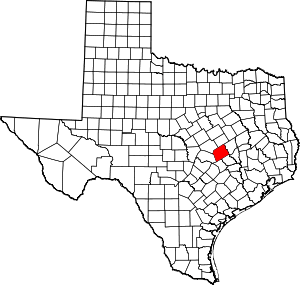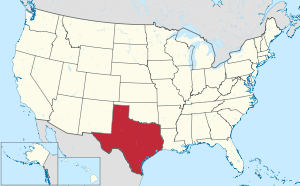Milam County, Texas
Milam County is a county located in the U.S. state of Texas. As of the 2010 census, its population was 24,757.[1] The county seat is Cameron.[2] The county was created in 1834 as a municipality in Mexico and organized as a county in 1837.[3][4] Milam County is named for Benjamin Rush Milam (pronounced "MY-lum"), an early settler and a soldier in the Texas Revolution.[5]
Milam County | |
|---|---|
 The Milam County Courthouse in Cameron. The Courthouse was added to the National Register of Historic Places on December 20, 1977. | |
 Location within the U.S. state of Texas | |
 Texas's location within the U.S. | |
| Coordinates: 30°47′N 96°59′W | |
| Country | |
| State | |
| Founded | 1837 |
| Named for | Benjamin Rush Milam |
| Seat | Cameron |
| Largest city | Rockdale |
| Area | |
| • Total | 1,022 sq mi (2,650 km2) |
| • Land | 1,017 sq mi (2,630 km2) |
| • Water | 4.8 sq mi (12 km2) 0.5%% |
| Population (2010) | |
| • Total | 24,757 |
| • Density | 24/sq mi (9/km2) |
| Time zone | UTC−6 (Central) |
| • Summer (DST) | UTC−5 (CDT) |
| Congressional district | 17th |
| Website | www |
Geography
According to the U.S. Census Bureau, the county has a total area of 1,022 square miles (2,650 km2), of which 1,017 square miles (2,630 km2) is land and 4.8 square miles (12 km2) (0.5%) is water.[6]
Major highways




Adjacent counties
- Falls County (north)
- Robertson County (northeast)
- Burleson County (southeast)
- Lee County (south)
- Williamson County (southwest)
- Bell County (northwest)
Demographics
| Historical population | |||
|---|---|---|---|
| Census | Pop. | %± | |
| 1850 | 2,907 | — | |
| 1860 | 5,175 | 78.0% | |
| 1870 | 8,984 | 73.6% | |
| 1880 | 18,659 | 107.7% | |
| 1890 | 24,773 | 32.8% | |
| 1900 | 39,666 | 60.1% | |
| 1910 | 36,780 | −7.3% | |
| 1920 | 38,104 | 3.6% | |
| 1930 | 37,915 | −0.5% | |
| 1940 | 33,120 | −12.6% | |
| 1950 | 23,585 | −28.8% | |
| 1960 | 22,263 | −5.6% | |
| 1970 | 20,028 | −10.0% | |
| 1980 | 22,732 | 13.5% | |
| 1990 | 22,946 | 0.9% | |
| 2000 | 24,238 | 5.6% | |
| 2010 | 24,757 | 2.1% | |
| Est. 2019 | 24,823 | [7] | 0.3% |
| U.S. Decennial Census[8] 1850–2010[9] 2010–2014[1] | |||
As of the census[10] of 2000, there were 24,238 people, 9,199 households, and 6,595 families residing in the county. The population density was 24 people per square mile (9/km²). There were 10,866 housing units at an average density of 11 per square mile (4/km²). The racial makeup of the county was 78.89% White, 11.05% Black or African-American, 0.50% Native American, 0.22% Asian, 0.01% Pacific Islander, 7.70% from other races, and 1.63% from two or more races. 18.63% of the population were Hispanic or Latino of any race. 16.7% were of American, 16.1% German, 7.2% English and 6.8% Irish ancestry according to Census 2000.
There were 9,199 households out of which 32.40% had children under the age of 18 living with them, 56.50% were married couples living together, 11.30% had a female householder with no husband present, and 28.30% were non-families. 25.90% of all households were made up of individuals and 14.10% had someone living alone who was 65 years of age or older. The average household size was 2.59 and the average family size was 3.11.
In the county, the population was spread out with 27.50% under the age of 18, 7.70% from 18 to 24, 24.70% from 25 to 44, 22.90% from 45 to 64, and 17.20% who were 65 years of age or older. The median age was 38 years. For every 100 females, there were 96.10 males. For every 100 females age 18 and over, there were 90.60 males.
The median income for a household in the county was $33,186, and the median income for a family was $40,431. Males had a median income of $30,149 versus $20,594 for females. The per capita income for the county was $16,920. About 12.20% of families and 15.90% of the population were below the poverty line, including 21.80% of those under age 18 and 15.30% of those age 65 or over.
Education
Six Independent School Districts (ISDs) are headquartered in Milam County:
- Buckholts Independent School District
- Cameron Independent School District
- Gause Independent School District
- Milano Independent School District
- Rockdale Independent School District
- Thorndale Independent School District.
Four additional districts extend into parts of Milam County, but are based in neighboring counties: Bartlett, Caldwell, Holland, and Rosebud-Lott.
St. Paul Lutheran School in Thorndale is a private institution that serves students in grades pre-kindergarten through eight.
Communities
Cities
- Cameron (county seat)
- Milano
- Rockdale
- Thorndale (small part in Williamson County)
Town
Unincorporated communities
- Ben Arnold
- Branchville
- Burlington
- Corinth
- Davilla
- Gause
- Marak
- Maysfield
- Minerva
- Pettibone
- San Gabriel
- Sharp
- Val Verde
Ghost towns
- Briary
- Bryant Station
- Bushdale
- Clarkson
- Duncan
- Gay Hill
- Lilac
- Nashville
- Nile
- Port Sullivan
- Silver City
- Sipe Springs
- Tracy
Politics
| Year | Republican | Democratic | Third parties |
|---|---|---|---|
| 2016 | 73.5% 6,364 | 23.7% 2,051 | 2.9% 249 |
| 2012 | 66.6% 5,481 | 32.0% 2,636 | 1.4% 113 |
| 2008 | 62.4% 5,217 | 36.4% 3,044 | 1.2% 96 |
| 2004 | 60.2% 5,291 | 39.2% 3,445 | 0.5% 47 |
| 2000 | 56.9% 4,706 | 41.5% 3,429 | 1.6% 134 |
| 1996 | 39.9% 3,019 | 51.1% 3,869 | 9.0% 679 |
| 1992 | 32.3% 2,414 | 47.4% 3,542 | 20.3% 1,512 |
| 1988 | 41.8% 3,512 | 57.9% 4,865 | 0.2% 19 |
| 1984 | 53.9% 4,384 | 45.9% 3,734 | 0.3% 22 |
| 1980 | 42.6% 3,251 | 55.5% 4,230 | 1.9% 146 |
| 1976 | 32.9% 2,404 | 66.6% 4,871 | 0.6% 40 |
| 1972 | 62.1% 3,554 | 37.8% 2,159 | 0.1% 6 |
| 1968 | 25.2% 1,614 | 51.0% 3,269 | 23.8% 1,526 |
| 1964 | 23.4% 1,334 | 76.5% 4,368 | 0.1% 7 |
| 1960 | 34.2% 1,898 | 65.5% 3,640 | 0.3% 18 |
| 1956 | 45.5% 2,486 | 54.3% 2,969 | 0.2% 11 |
| 1952 | 43.9% 2,539 | 55.9% 3,227 | 0.2% 12 |
| 1948 | 15.1% 646 | 76.0% 3,261 | 9.0% 385 |
| 1944 | 12.5% 623 | 71.1% 3,537 | 16.4% 814 |
| 1940 | 21.3% 1,110 | 78.4% 4,083 | 0.3% 16 |
| 1936 | 6.6% 288 | 93.0% 4,077 | 0.4% 18 |
| 1932 | 5.3% 264 | 94.2% 4,676 | 0.5% 23 |
| 1928 | 30.9% 1,270 | 69.1% 2,842 | 0.1% 4 |
| 1924 | 14.7% 930 | 80.3% 5,087 | 5.0% 317 |
| 1920 | 7.7% 371 | 53.8% 2,598 | 38.5% 1,859 |
| 1916 | 19.2% 576 | 73.1% 2,198 | 7.8% 234 |
| 1912 | 8.8% 244 | 69.6% 1,939 | 21.7% 604 |
See also
References
- "State & County QuickFacts". United States Census Bureau. Archived from the original on October 18, 2011. Retrieved December 22, 2013.
- "Find a County". National Association of Counties. Retrieved 2011-06-07.
- "Texas: Individual County Chronologies". Texas Atlas of Historical County Boundaries. The Newberry Library. 2008. Retrieved May 28, 2015.
- "Milam County". Texas Almanac. Texas State Historical Association. Retrieved June 23, 2015.
- Gannett, Henry (1905). The Origin of Certain Place Names in the United States. U.S. Government Printing Office. p. 207.
- "2010 Census Gazetteer Files". United States Census Bureau. August 22, 2012. Retrieved May 4, 2015.
- "Population and Housing Unit Estimates". United States Census Bureau. May 24, 2020. Retrieved May 27, 2020.
- "U.S. Decennial Census". United States Census Bureau. Retrieved May 4, 2015.
- "Texas Almanac: Population History of Counties from 1850–2010" (PDF). Texas Almanac. Retrieved May 4, 2015.
- "U.S. Census website". United States Census Bureau. Retrieved 2011-05-14.
- Leip, David. "Dave Leip's Atlas of U.S. Presidential Elections". uselectionatlas.org. Retrieved 7 April 2018.
